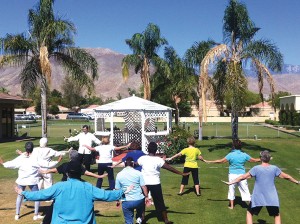There are more than 120 arthritic conditions, so it is no wonder that most of us will experience symptoms at some point in our life. According to the Centers for Disease Control and Prevention, nearly 1 in 2 people may develop symptomatic knee osteoarthritis, and 1 in 4 may develop painful hip arthritis. An estimated 50 million U.S. adults annually are advised that they have some form of arthritis, including 50% of adults 65 years or older.
While there is no cure for arthritis, healthy lifestyle changes can help reduce arthritic pain and keep you moving forward.
Understanding Your Arthritis
If you have debilitating pain, it is important to seek and secure a proper diagnosis in order to make educated treatment choices. Beyond common rheumatoid and osteoarthritis, arthritic conditions are vast and include fibromyalgia, gout, flat feet and myofascial pain syndrome, where pressure on sensitive muscle points causes pain in seemingly unrelated body parts.
Medications, treatment programs, exercise and even the foods you eat, can affect different forms of arthritis positively and negatively. Once you understand the cause of your pain, you are better prepared to manage it.
The most common types of arthritis are:
Oesteoarthritis (OA) afflicts almost 27 million Americans and is the most common type of arthritis.1
A chronic degenerative joint disease, it occurs as a result of wear and tear on a joint’s cartilage, which causes bones to rub against each other. Stiffness, pain and loss of movement in the joint can result.
The condition can begin as early as age 40 (occurrence in younger people is often due to injury). Overuse and body weight influence OA’s onset and treatment focuses on managing pain and improving function.2
Rheumatoid arthritis (RA) is a chronic inflammatory disorder that typically affects the small joints in your hands and feet. Unlike the wear-and-tear damage of osteoarthritis, rheumatoid arthritis affects the lining of your joints, causing a painful swelling that can eventually result in bone erosion and joint deformity.
An autoimmune disorder, RA occurs when your immune system mistakenly attacks your own body’s tissues. RA is more common in women than in men, and generally occurs between the ages of 40 and 60.3 Treatment focuses on controlling symptoms, preventing joint damage, and reducing inflammation.
Gout usually affects only one or a few joints (frequently the big toe and ankle) and is reported by an estimated 6.1 million people.4 It is caused by the build-up of uric acid crystals within the joint resulting in a sudden onset of intense pain, swelling, warmth, and redness. Attacks frequently occur at night and can be triggered by stressful events, alcohol or drugs, or the presence of another illness. Early attacks usually subside within 3 to 10 days, even without treatment, and the next attack may not occur for months or even years. The goals of treatment are to ease the pain and inflammation that come with sudden attacks, prevent future attacks, stop uric acid build-up in the tissues and joint space between two bones, and prevent kidney stones from forming.2
Avoid Foods That Enhance Symptoms
Many foods cause inflammation and small changes in your diet can yield big rewards. According to Dr. Hessam Mahdavi of Eisenhower’s Wellness Institute, these foods include gluten, corn, dairy products, soy and sugar. Can’t live without them? Great alternatives include many readily available gluten-free products, brown rice pasta and chips, almond milk, and fresh seasonal fruit.
Swap sunflower, safflower, corn and soybean oils, which are high in inflammation causing omega-6 fatty acids, for extra virgin olive oil which contains oleocanthal, an organic compound that blocks enzymes involved in inflammation.
Gout sufferers beware of shellfish, red meat, high fat dairy foods, and beer. Gout results from the build-up of uric acid in the blood, and purine, a compound that’s abundant in these foods converts to uric acid. Opt for lean meat, poultry, fish and beans which also offer muscle-relaxing magnesium and bone-building calcium.5
Also realize that every pound you carry around your belly puts 10 pounds of pressure on your joints, so slimming down should be a priority.5
Eat Foods That Reduce Symptoms
Did you know that Omega-3s decrease the production of chemicals that spread inflammation and inhibit enzymes that trigger it?6 This is a primary reason to take your fish oil supplement and to eat foods rich in Omega-3s including walnuts, flax seeds, canola oil and pumpkin seeds–all great additions to your salad or cereal! Salmon and sardines are beneficial fatty fish also containing vitamin D, which is shown to prevent swelling and soreness.
Studies show that quercetin may also inhibit inflammatory chemicals, much like aspirin and ibuprofen.7 Foods rich in quercetin include onions, leeks, kale, cherry tomatoes and apples.
Raw nuts are a healthy snack, and Brazilian nuts may be especially beneficial to those with arthritis as they are particularly rich in selenium. Low levels of selenium have been linked to RA.5
Several studies suggest that an effective food for reducing chronic inflammation and easing pain is the tart cherry. Researchers from Oregon Health & Science University who studied a group of women ages 40 to 70 with inflammatory osteoarthritis found that those drinking tart cherry juice twice a day for three weeks experienced “significant reductions in important inflammation markers.” Women with the highest inflammation markers at the beginning of the study showed the most notable changes. A 2009 study at Baylor Research Institute found that 56% of patients with osteoarthritis had more than 20% improvement in pain and function after taking cherry pills for eight weeks.8
Dr. Oz notes that the magic ingredient is anthocyanins, the pigments that give cherries their vibrancy. He adds that tart cherries also fight heart disease and act as a sleep aid by increasing melatonin in the brain and recommends a glass with dinner or at least 3 hours before bedtime.
Get Moving

Dr. Robert Haberkorn introduces Tai Chi to guests at the Arthritis Foundation’s Senior Health Day held at the Joslyn Center in Palm Desert
The National Institutes of Health and the Arthritis Foundation both agree that movement is a key component in managing arthritis pain. But how do you exercise when walking or even opening a jar is challenging?
You may think exercise will aggravate your joint pain and stiffness but that’s not the case. According to the Mayo Clinic, lack of exercise can actually make your joints more painful. Keeping your muscles and surrounding tissue strong is crucial to maintaining bone support. Not exercising weakens those supporting muscles, creating more stress on your joints and thus more pain.
“It’s so important to move–even if it’s only 10 minutes a day,” said Shanna Hirschi, Director of the Arthritis Foundation’s Coachella Valley division. “Once you start exercising, your body will feel better.” The Foundation offers over 200 exercise classes weekly throughout the valley.
Low impact exercises like swimming or walking are recommended and mind-body practices like yoga and tai chi are especially beneficial for improving muscle strength, flexibility, and balance.
The slow, graceful movements of Tai Chi, which has been practiced for thousands of years, can improve balance, reduce stress and offer pain relief. Researchers at Tufts Medical Center in Boston found that Tai Chi can specifically reduce the pain and physical impairment of people with severe knee OA.8
Arthritis pain does not have to control your life. Talk with your doctor or health care provider to understand your specific condition and the treatment options available. And start making lifestyle changes that minimize symptoms and maximize your quality of life.
For more information contact the Arthritis Foundation office in Palm Desert at 760.773.3076 or visit www.Arthritis.org.
References: 1) Arthritis Foundation (arthritis.org); 2) National Institutes of Health; 3) Mayoclinic.org; 4) Centers for Disease Control & Prevention; 5) Arthritis Remedies: 10 Foods That Help and Hurt Fight Flare-Ups With an Arthritis Diet By Dorothy Foltz-Gray, Special to Lifescript Reviewed By Edward C. Geehr, M.D.Published May 12, 2012; 6) University of Birmingham; British Heart Foundation: Omega-3 Research Sheds Light on Inflammation Trigger; Aug 25, 2009. 7) National Institutes of Health Research: The antioxidants curcumin and quercetin inhibit inflammatory processes associated with arthritis. Jackson JK, Higo T, Hunter WL, Burt HM.; 8) ArthritisToday.org;








































Comments (0)